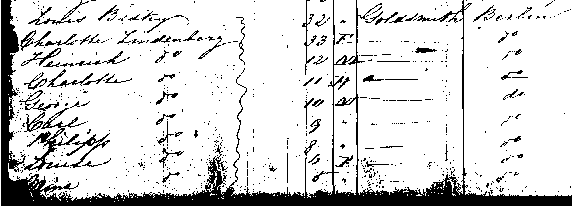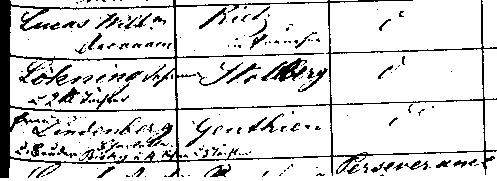
Dr. John Terence Golden (Immigrant Editor)
2609 Summit St., Columbus OH 43202-2432
(First published in: The Palatine Immigrant 22(1997)3, 155-157)
In 1848, when Germany was a loose collection of independent political
entities, there developed a revolutionary movement toward democracy and
national union. A democratic legislature began holding meetings in the
Pauluskirche (St. Paul’s Church) in Frankfurt. The movement met with the
diasapproval of the powers-that-be, in particular the kings of Prussia,
Saxony and Bavaria, and was quickly put down. A number of supporters, including
many German intellectuals, had to flee the country.
Among these was Theodore Lindenberg, born in about 1808, who had graduated
from a German univesity and was appointed a judge for life. He came to
Columbus, Ohio in 1849, and was followed in 1850 by his wife Charlotte,
brother-in-law Louis Bisky, and children ranging from 12 down to 5 - Heinrich,
Charlotte, George, Carl, Philipp, Louise and Wilhelmina. A daughter, Emilie,
was born in Ohio in about 1852. He first attempted to enter the American
legal profession, and is listed as a lawyer in the 1850 census. Due to
difficulties with the language, he could not continue in this profession,
but being resourceful, he found other ways to earn a living. In the 1860
census, he is listed as a grocer. The 1861-62 directory shows him running
a beer and bowling saloon, shooting gallery and boarding house at 184 S.
High. Later, he was a manufacturer of cigars, and at the time of his death,
at age 66, on December 22, 1873, the death record lists his occupation
as printer.
His family did well, becoming involved with M.C. Lilley in the M.C.
Lilley Company, a printing firm which had publications including the Odd
Fellows Companion. The Odd Fellows wear spezial regalia on certain occasions,
and due to reader request for such, the firm expanded to include manufacture
of regalia, and later, all sorts of uniforms. At its peak, the firm had
grown into four large buildings at the corner of E. Long and N. 6th streets.
It became the Lilley-Ames Company following a purchase in 1933 during the
depression, and continued until 1965. Theodore’s oldest son, on his death,
left his home to the State of Ohio for use as the governor’s mansion. It
was used as such for a time, but now houses the Columbus Foundation, which
assists various non-profit charitable and educational organizations, including
Pal-Am, with certain financial matters.
Doing research on this family for friends, your editor had collected
many records, but the place of origin remained uncertain. It was given
as „Guentheim“ in a county history. In a trip to Fort Wayne, your editor
had an hour or two to spend on research at the library, and spotted the
„Germans to America“ series on a shelf. In a matter of minutes, he found
Theodore’s wife, children and brother-in-law in the first volume, for 1850.
| BISKY | , LOUIS | 32 | M | GDSM | PRB48NY |
| LINDENBERG | , CHARLOTTE | 33 | F | UNKNOWN | PRB48NY |
| HEINRICH | 12 | M | UNKNOWN | PRB48NY | |
| CHARLOTTE | 11 | F | UNKNOWN | PRB48NY | |
| GEORGE | 10 | M | UNKNOWN | PRB48NY | |
| CARL | 9 | M | CHILD | PRB48NY | |
| PHILIPP | 8 | M | CHILD | PRB48NY | |
| LOUISE | 6 | F | CHILD | PRB48NY | |
| MINA | 5 | F | CHILD | PRB48NY |
| SHIP: | BRITISH QUEEN |
| FROM: | HAMBURG |
| TO: | NEW YORK |
| ARRIVED: | 09 MAY 1850 |

The passenger list gave the family origin as „Berlin“ also. The index gave Hamburg as the port of departure, and the library also had the Hamburg emigration lists, which begin in the same year. Knowing the date of arrival, the date of departure could be estimated. The first years are not indexed, but all the A’s, B’s, C’s, and such are together in groups, and on one of the first pages of L’s, there were the Lindenbergs. Departure was on 1 April 1850, thus 39 days at sea.

In German script, it says, „Mrs. Lindenberg, Charlotte, Brother Bisky, 4 sons and 3 daughters.“ The home town is „Genthien.“ This sounds much more like Guentheim, and is no doubt D-39307 Genthin, a small town near Berlin, on the canal connecting Berlin to the Elbe, Hamburg and the sea. A check of the Genthin records will now be made.
In short, „Germans to America“ may not be completely reliable - no index is. However, if you use it as a guide to finding more reliable sources, it can be an extremely useful tool.
| [HOME] | [GERMAN] | [DATA PROTECTION] |
| Research Center German Emigrants in the USA: DAUSA * Prof.(pens.) Dr. Antonius Holtmann Brüderstraße 21 a -26188 Edewecht - Friedrichsfehn *Kontakt: antonius.holtmann@ewetel.net | ||